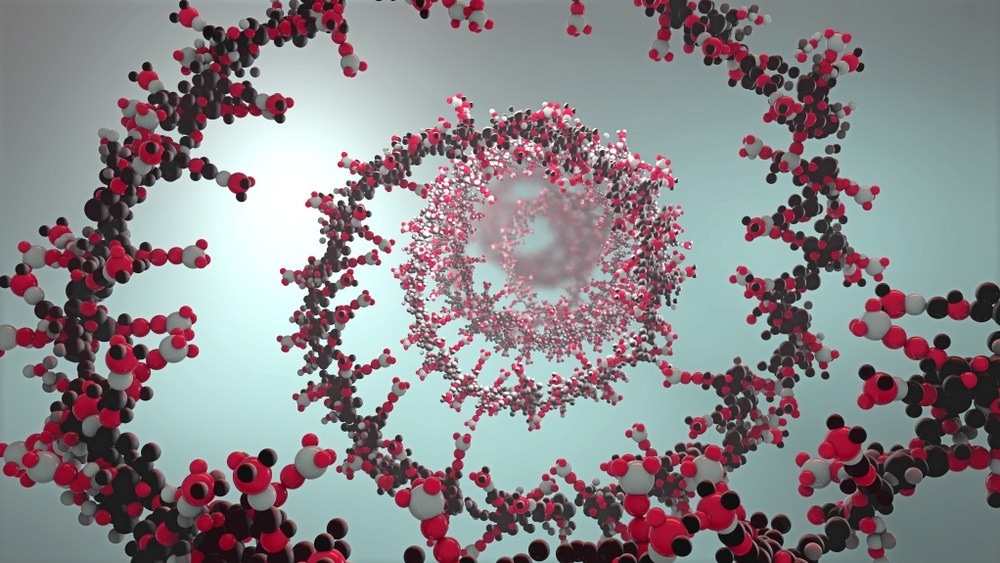Sponsored Content by PittconJul 2 2020
Dr. Chad Mirkin, Director of International Institute for Nanotechnology talks to News-Medical Life Science about the use of spherical nucleic acids (SNAs) in vaccinations and treatments for disease, and what they show about the importance of structure in pharmaceutical development.
What are spherical nucleic acids (SNAs)?
Spherical nucleic acids (SNAs) are structures that are made by taking nanoparticles and synthesizing short snippets of DNA or RNA that are terminated with groups that can chemically bond to the particles. Under appropriate conditions, you can load up the short snippets of DNA or RNA onto the surface of the particles so that they adopt the shape of the central particle core.

Image Credit: Christoph Burgstedt / Shutterstock.com
What properties make SNAs useful for medical research and development?
What is really interesting about an SNA is that, on a sequence basis, it naturally has completely different properties to its linear cousin. It interacts with biological systems completely differently.
For example, if you feed linear nucleic acids to human cells, they will reject them. The reason behind this is that the cell membrane is negatively charged and the DNA is also negatively charged.
However, if you take that same set of DNA strands and arrange them in spherical nucleic acid form, not only do they go in, they go in better than anything known to man.
This is an interesting observation. The reason for it is that there are receptors on the surface of the cells that recognize the clustered oligonucleotides in the form of the spherical nucleic acid. These receptors, called scavenger receptors, localize them on the cell membrane and then facilitate a process called caveolae-mediated endocytosis.
Once internalized, you can then use those structures to make measurements inside cells. You can also use them to regulate what cells do. You can use them in gene regulation approaches, you can use them as immunostimulatory agents, and you can use them to develop a lot of analytical tools and possible therapeutics.
How can these properties be exploited in the creation of SNA based vaccines?
With a vaccine, you have two basic components. You have something called an adjuvant, which is a molecule that stimulates your immune system, and you have something called an antigen, typically a peptide signature that helps train the immune system.
With a spherical nucleic acid vaccine, you take advantage of the fact that this type of architecture can enter cells such as dendritic cells and antigen-presenting cells which are really important in the immune system. Certain sequences of DNA or RNA can be used to selectively stimulate those cells.
In addition, they can carry things in with them if you put something in their cores or load upon them a particular type of antigen, for example, structures that train the immune system by training T cells to give a very selective killer response.
For example, if you are trying to develop a cancer vaccine, you basically take a spherical nucleic acid made of the appropriate adjuvant molecules and you load into them, or onto them, the appropriate peptide signatures that are unique to those cancer cells. You then locally stimulate, for example, the subcutaneous injection. You train those cells to train T cells to selectively go out into the lymphatic system, find cells that have those signatures, the cancer cells, and selectively lyse them.

Image Credit: PhotobyTawat / Shutterstock.com
You recently demonstrated the ability of SNAs to deliver DNA to different regions of the body. Can you tell us more about this research?
In addition to getting into cells well, spherical nucleic acids have very different biodistribution profiles than linear nucleic acids. So, when they are systemically administered, they go to all regions of the body. They can enter the lung, they can enter the epithelial cells, they can enter the liver, they can cross the blood-brain barrier, and they can get into the heart.
The SNA structure makes a difference on a basic level, but it also means that you can then use this understanding to begin to create new approaches to therapies. Very recently, we have learned how to take spherical nucleic acids deep into the brain by intrathecally injecting them into the spinal cord, which gives them access to all parts of the brain.
This is exciting for the development of drugs to treat neurodegenerative disorders. As a result, we are beginning to look at this first in the area of Friedreich's ataxia, a genetic disease that affects a significant number of people, but also in spinal muscular atrophy, a disease that affects young children. We are also aiming to investigate a wide range of other types of disorders, such as Huntington disease, Parkinson's disease, and Alzheimer's disease.
Next Generation Vaccines with Spherical Nucleic Acids (SNAs)
Next Generation Vaccines with Spherical Nucleic Acids (SNAs) from AZoNetwork on Vimeo.
At Pittcon 2018, you presented three structural SNAs that had the differing anti-tumor efficiencies. How do these structures differ and how did this change their ability to target the tumors?
One of the interesting things about vaccine development is that in some respects it is amazing vaccines even work at all. When you get a vaccine, the adjuvant and antigen are often just coinjected into a person and then you let nature take its course. You do not control the activity or biodistribution properties by presenting them in a particular structure.
What we have done with spherical nucleic acid vaccines is we have learned firstly how to control the amount of adjuvant, secondly how to control the amount of antigen, and thirdly how to present them in different ways.
I think the conventional way that people develop vaccines is the blender approach, which consists of taking the actions of components, putting them in and hoping they work. If they work, you can run with it. If they do not work, you move on to the next set of components.
We have asked the basic question: does structure make a difference? Say you have something that works, can you make it better by controlling the structure in the way those components are presented in the context of a spherical nucleic acid?
The answer is that structure makes a huge difference. We have been able to look at three different structures systematically across many different animal models for cancer, and we have shown consistently that one of the three structures outperforms the others substantially.
On one end of the spectrum, you have completely ineffective vaccines, and in the other case, you have totally curative vaccines, which is remarkable. That has many implications. One implication is that it says we are probably designing vaccines incorrectly and we can do a lot better.
A second implication is that it makes you wonder about where people have looked for possible components for adjuvants and antigens and decided they did not work in a vaccine. Did they have the wrong components, or did they have the wrong structure? It could have been that they had perfectly fine components, but they presented them in the incorrect way for the type of response they wanted.
How far are vaccines based on spherical nucleic acids from routine clinical use?
They are on the horizon. There are a whole series of drugs based upon spherical nucleic acids that are now in human clinical trials, such as drugs for diseases like psoriasis and atopic dermatitis, and also for glioblastoma multiforme, a deadly form of brain cancer.
There are even drugs in clinical trials for treating a wide variety of cancers where you use spherical nucleic acids as a stimulant for the immune system. There are also ones where you couple that stimulation with drugs called checkpoint inhibitors which can give you a combined type of response.
We are systematically pushing the development of spherical nucleic acids from the benchtop at a lab to the clinic. There are now many shots at making this happen and many ongoing major trials that are going to tell the story going forward. Hopefully, it is going to be a very bright story for spherical nucleic acids and they will be broadly used for treating many different diseases.

Image Credit: Kateryna Kon / Shutterstock.com
What do the next few years look like for you in your research?
We really want to push this concept of structure making a difference. I am a chemist by training. I believe that if you look at the history of pharmaceutical development, structure has always been important. Sometimes very subtle changes in the structure of a drug can have a really big impact on its performance.
The same has to be true with vaccines; we just have not had a platform to systematically look at how structure makes a difference there. However, now we do. We are really going to push this concept of rational vaccinology, the idea that rational design through an understanding of how structure translates to activity differences and can lead to increased performance in terms of therapeutics.
I think this is a really important concept, not just for spherical nucleic acids, but for nanomedicines and macromolecular approaches to developing medicines in general, because you tend to move away from the discrete architecture.
The bigger you go, the more complex you get. However, I think that also creates an opportunity in that the structural considerations there could be an important knob that you can turn to adjust efficacy.
Why did you come to Pittcon?
Pittcon is great. They do a phenomenal job of attracting super smart people to whatever area they are in. They have on display state-of-the-art equipment and capabilities, and they put together a scientific program that is truly spectacular and attracts some of the best and brightest from all over the world.
It is a great way to learn about everything important in terms of science, the instrumentation, and the science being conducted with that instrumentation.
Why do think you Pittcon is important for the analytical chemistry industry and the overall science industry?
Pittcon is central to the whole analytical science industry. I do not think there is any other venue that puts together a better show and puts together a better platform of the state-of-the-art, both on the instrument side and on the science side. If I think of one show that I want to go to, it is Pittcon.
About Dr. Chad Mirkin
Dr. Chad A. Mirkin is the Director of the International Institute for Nanotechnology and the George B. Rathmann Prof. of Chemistry, Chemical & Biological Engineering, Biomedical Engineering, Materials Science & Engineering, and Medicine at Northwestern University.
He is a chemist and a world-renowned nanoscience expert, who is known for his discovery and development of spherical nucleic acids (SNAs) and SNA-based biodetection and therapeutic schemes, Dip-Pen Nanolithography (DPN) and related cantilever-free nanopatterning methodologies, On-Wire Lithography (OWL), and Co-Axial Lithography (COAL), and contributions to supramolecular chemistry and nanoparticle synthesis.
He is the author of over 780 manuscripts and over 1,200 patent applications worldwide (over 350 issued), and he is the founder of multiple companies, including Nanosphere, AuraSense, and Exicure, which are commercializing nanotechnology applications in the life sciences and biomedicine.
 Mirkin has been recognized with over 230 national and international awards, including the Kabiller Prize in Nanoscience and Nanomedicine, the 2016 Dan David Prize and the inaugural Sackler Prize in Convergence Research. He was a member of the President’s Council of Advisors on Science & Technology (Obama Administration), and is one of very few scientists to be elected to all three US National Academies. He is also a Fellow of the American Academy of Arts and Sciences and the National Academy of Inventors, among others.
Mirkin has been recognized with over 230 national and international awards, including the Kabiller Prize in Nanoscience and Nanomedicine, the 2016 Dan David Prize and the inaugural Sackler Prize in Convergence Research. He was a member of the President’s Council of Advisors on Science & Technology (Obama Administration), and is one of very few scientists to be elected to all three US National Academies. He is also a Fellow of the American Academy of Arts and Sciences and the National Academy of Inventors, among others.
Mirkin has served on the Editorial Advisory Boards of over 30 scholarly journals, including JACS, Angew. Chem., and Adv. Mater.; at present, he is an Associate Editor of JACS and and PNAS Editorial Board Member. He is the Founding Editor of the journal Small, and he has co-edited multiple bestselling books.
Mirkin holds a B.S. degree from Dickinson College (1986, elected into Phi Beta Kappa) and a Ph.D. degree from the Penn. State Univ. (1989). He was an NSF Postdoctoral Fellow at the MIT prior to becoming a professor at Northwestern Univ. in 1991.
About Pittcon
 Pittcon® is a registered trademark of The Pittsburgh Conference on Analytical Chemistry and Applied Spectroscopy, a Pennsylvania non-profit organization. Co-sponsored by the Spectroscopy Society of Pittsburgh and the Society for Analytical Chemists of Pittsburgh, Pittcon is the premier annual conference and exposition on laboratory science.
Pittcon® is a registered trademark of The Pittsburgh Conference on Analytical Chemistry and Applied Spectroscopy, a Pennsylvania non-profit organization. Co-sponsored by the Spectroscopy Society of Pittsburgh and the Society for Analytical Chemists of Pittsburgh, Pittcon is the premier annual conference and exposition on laboratory science.
Proceeds from Pittcon fund science education and outreach at all levels, kindergarten through adult. Pittcon donates more than a million dollars a year to provide financial and administrative support for various science outreach activities including science equipment grants, research grants, scholarships and internships for students, awards to teachers and professors, and grants to public science centers, libraries and museums.
Visit pittcon.org for more information.